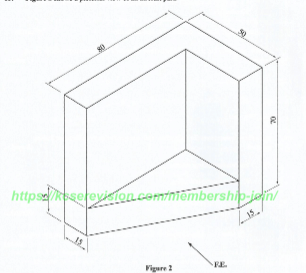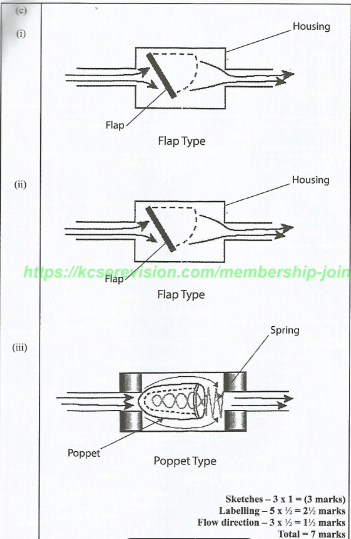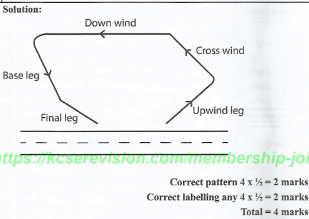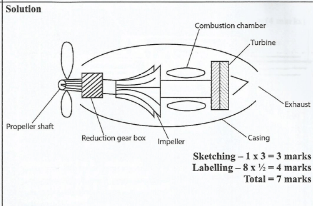QUESTIONS
SECTION A (44 Marks)
Answer all questions in this section
- Highlight three main duties of aircaft cabin crew (3 marks)
- Explain three external tasks undertaken when picketing a high fixed wing aircraft. (3 marks)
- Outline three effects of wind on an aircraft in fligh (3 marks)
- With the aid of a labelled sketch, explain the airflow over a flat plate perpendicular to the relative airflow. (3 marks)
-
- Outline the procedure of cutting external threads using the circular die (5 marks)
- Explain three functions of the primary control surfaces. (3 marks)
-
- State and explain, Bernoullis quation as applied to total pressure (2 marks)
- With the aid of a labelled sketch, show how lift is produced on an aerofoil. (3 marks)
- State one property and one application for each of the following metals used in the construction of aircrafts. (3 marks)
- Copper
- Magnesium alloy
- Stainless steel
- Differentiate between each of the following: (4 marks)
- One cycle and Brayton cycle
- Wet sump and dry sump
-
- Give three reasons foe selecting titanium alloys for use on aircraft engines. ( 3 marks)
- Explain the function of each of the following aircraft structural memebers. (3 marks)
- Strut
- Rib
- Tie
- Figure 1 shows a plan of a metal plate with two circles of different diameters. Dimension the distance between the centres of the circles on the plate. (6 marks)

SECTION B (56 marks)
Answer any four questions from this section in the spaces provided Question 15 should be answered on the A3 paper provided. Candidates are advised to spend not more than 1 hour on question 15.
-
- With the aid of labelled sketch, describe the construction of the primary circuit of the magneto system (10 marks)
- Using a labelled sketch, show an aero gas turbine engine subsonic intake. (4 marks)
-
- Explain eight tasks carried out on an aircraft between flights. (8 marks)
- Explain four range marking for a typical airspeed indicator. (4 marks)
- State four ways of avoiding detonation in aero piston engines during the various phases of ground and flight operations. (2 marks)
-
- Outline the importance of each of the following ramp operations: (3 marks)
- Engine starting services
- Refueling
- Marshalling
- Outline the four aspects considered in human factors. (4 marks)
- Sketch and label the cross-sectional views of each of the following types of check valves: (7 marks)
- Flap
- Ball
- Poppet
- Outline the importance of each of the following ramp operations: (3 marks)
-
- Give three instruments for each of the following radio beacon direction finding (3 marks)
- Instrument landing system
- Radio magnetic indication
- With the aid of labelled sketches, show the air traffic pattern at a controlled port (4 marks)
- Sketch and label the cross sectional view of a turbo propeller centrifugal gas turbine engine (7 marks)
- Give three instruments for each of the following radio beacon direction finding (3 marks)
- Figure 2 shows a pictorial view of an aircraft part.

On the A3 paper provided, draw to a scale of 2:1 each of the following views in first angle projection.- Front elevation in the direction of arrow F.E
- End elevation
- Plan
MARKING SCHEME
- Solution:
- Attending pre-flight briefing with the captain about flight pl length, weather conditions and potential lay overs
- Fill refreshment supplies and check safety equipment and serving meals.
- Giving safety procedure requirements and instructions.
- Administer first aid to passengers
- Communicating safety instructions from the captain to the passengers (Any 3x1-3 marks) 3 marks
- Solution:
- Aircraft must be parked into wind.
- The aircraft must be secured from the picketing points to suitable on the ground.
- Pitot covers must be fitted
- Wheels should be choked forward and aft
- Propeller and intake cover should be well fitted
- Ensure security of doors and latches
(Any 3x1=3 marks) 3 marks
- Solution:
- They Streamline tail winds will increase spoed.
- If the aircraft flies in o wind then its ground speed decreases landing speed. Reduced (headwind)
- Non-uniform winds cause turbulence. This leads to a bumpy experience. Landing is not allowed in severe cross winds.
- Headwind increases the lift generated hence the aircraft can land at lower speeds.
(Any 3 x 1-3 marks) 3 marks
-

The flat plate presents 100% resistance to forward motion hene maximum drag. -
- Solution:
- Secure work in a vice.
- Taper the end of rod to ease the start (chamfering)
- Slacken the two outer screws in the stock and tighten the centre screws.
- Place the stock and die squarely on the rod and start cutting. Turn clockwise 180° clockwise and 90° anti-clockwise as you lubricate
- With the thread cut, try a nut.
- Re-tighten the screws to recut if needed.
- Repeat process until nut is a good fit on the thread
Any 5x1-(5 marks) 5 marks
- Solution:
- They provide control and trim about the three aircraft axes.
- The rudder provides control about the vertical axis (directional control, yawing). Also known as normal axis.
- Elevator controls the aircraft about the lateral axis (pitching motion).
- The ailerons move differently to give roll control along the longitudinal axis.
Any 3x1-(3 marks)
- Solution:
-
- The sum of potential (static) energy and kinetic energy per unit volume is always constant
- Ps+ 1⁄2 pv2 = K
- Static pressure (Ps) plus dynamic pressure (1⁄2 pv2) = constant.
-

- The sum of potential (static) energy and kinetic energy per unit volume is always constant
-
- Solution: Copper is:
- Very ductile can be drawn easily
- Good conductor of electricity
- High resistance to corrosion
- Used for electrical purposes because of its goods electrical conductivity.
Any 2 x = (1 mark)
- Solution: Magnestum is:
- Light and strong
- Used in castings and structure members in the fesetip-join
- Used in handling gear systems i.e hubs, torque links
- Used as an alloy with steel
2 x 1⁄2- (1 mark)
- Solution: Stainless steel is:
- Strong, tough, corrosion resistance and shock resistance.
- Applied in bearings, exhaust systems, firewalls and shock strut (landing gear).
Any 2x-(1 mark) 3 marks
- Solution: Copper is:
-
- Solution:
In the Otto cycle combustion takes place at constant volume; while In the Brayton cycle, combustion takes place at constant pressure.
2x1-(2 marks) 2 marks - In wet sump lubrication, the internal parts are lubricated by oil stored in the sump while In dry sump engines, the sump consists an integral part of the crank case where scavenge pumps return the oil to a separate storage tank.
2x1-(2 marks)
- Solution:
-
-
- They have resistant to high temperature up to 400°C.
- They have excellent corrosion resistant properties.
- They have excellent strength to weight ratio.
3x1-(3 marks) 3 marks
- Solution:
- Strut is a structural member that takes up comprehensive loads.
- The rib strengths and gives the wing its profile (shape)
- Tensional loads and stresses in the aircraft are absorbed by ties.
3x1-(3 marks) 3 marks
-
-

SECTION B
-
- Solution:
- The primary electrical circuit in a magneto consists of the primary winding of an insulated magneto coil of copper wire.
- A set of breaker points and a capacitor.
- The wire is coated with enamel insulation and is wound directly over the core in the magneto circuit.
- One end of the primary winding is attached to a ground lead while the other end connects to one end of the secondary winding and the ungrounded, or insulated, side of the breaker points.
- To open the points, a can mounted on the end of the rotating magnet shaft is used for force one contact away from the other.
- A capacitor is installed in parallel with the points.

- Solution:

- Solution:
-
- Solution:
- Towing-The movement of an aircraft using mechanical equipment such as tow-struck or tug
- Refueling The process to refill the aircraft w th feel which may also entail the process of refueling and defueling
- Connection of electrical power-The provision of an external electrical supply to operate ground services.
- Gas charging The replenishment of gaseous compounds such as oxygen and nitrogen.
- Replenishment of liquids - the replacement of hydraulic fluid, wate and de-icing fluids
- Lubrication-the greasing and oiling of mechanical moving parts.
- Replacement of materials, equipment of the aircraft for the next flight
- Cleaning-the restoration of the aircraft to high degree of cleanliness throughout, including the removal of litter, food remnants and the disposal of toilet waste.
- Replenishment of catering services
- Pre-flight inspectio /checks
- Loading and offloading of go
- Marshalling
- De-icing
Any 8 x 1 = (8 marks) 8 marks
- Solution:
- Red radial lines-maximum and minimum limits of airspeed
- Yellow arc-precautionary ranges
- Green are-normal operating ranges
- White arc-Ranges in which the flaps may be lowered
Any 4x 1-(4 marks) 4 marks
-
- Make sure the proper grade of fuel is used.
- Keep the cowl flaps (if available) in the full-open pos tion while on the ground to provide the maximum airflow through the cowling
- Use an enriched fuel mixture, as well as a shallower climb angle to increase cylinder cooling during takeoff and initial climb
- Avoid extended high power steep climbs.
- Develop the habit of monitoring the engine instruments to verify proper operation according to procedures established by the manufacturer in RPM
Any 4x 1⁄2 -(2 marks)
- Solution:
-
- Solution:
- When the engine starting power is not adequate to assist the engine to attain self sustaining speed.
- When fuel range is depleted for flight or ground running, op up is nocessary (fuel uplift) to increase the range of aircraft endurance.
- The pilot may not be able to see clearly the wing tips and the tail, marshaling enables the pilot to clear or maneuver safely on ground.
3 marks
- Solution:
- Software- These are procedures used to accomplish a task.
- Handware-the tools, equipment or machines available for work.
- Environment-Conducive working environment
- Livewire-the human input -Employing the right people for the job. Include proper training and work ethics.
4x1-(4 marks) 4 marks
- Solution:
-
- Solution
-
- Glide slope
- Marker
- Localized
-
- Very high omni (VOR)
- Automatic direction finder (ADF
- Non directional beacon (NDB)
6x 1⁄2 -3 marks 3 marks
-
- Solution:

- Solution

- Solution
-

Download Aviation Technology Paper 1 Questions and Answers - KCSE 2022 Past Papers.
Tap Here to Download for 50/-
Get on WhatsApp for 50/-
Why download?
- ✔ To read offline at any time.
- ✔ To Print at your convenience
- ✔ Share Easily with Friends / Students
